MGT501 Business Environment: Tata Projects Stakeholder Analysis
VerifiedAdded on 2022/09/18
|14
|3437
|41
Report
AI Summary
This report provides a comprehensive stakeholder analysis of Tata Projects, a prominent construction business in India. It begins with an executive summary and an introduction to the construction industry's significance in India's GDP and Tata Projects' role within it. The report outlines the company's functional areas, including engineering, HR, communication, legal, finance, design, IT, marketing, quality assurance, R&D, and international services. It identifies and details the roles of internal stakeholders such as board of directors, investors, employees and managers and external stakeholders including suppliers, communities, government, competitors, and clients. The report further explores the nature and degree of stakeholder interests, potential conflicts, and their levels of influence, including an analysis of their interactions. A matrix of stakeholders is drawn to analyse the stakeholder’s behaviour of Tata Project. The report concludes with a comparison to industry standards and a conclusion summarizing the key findings. References are provided.
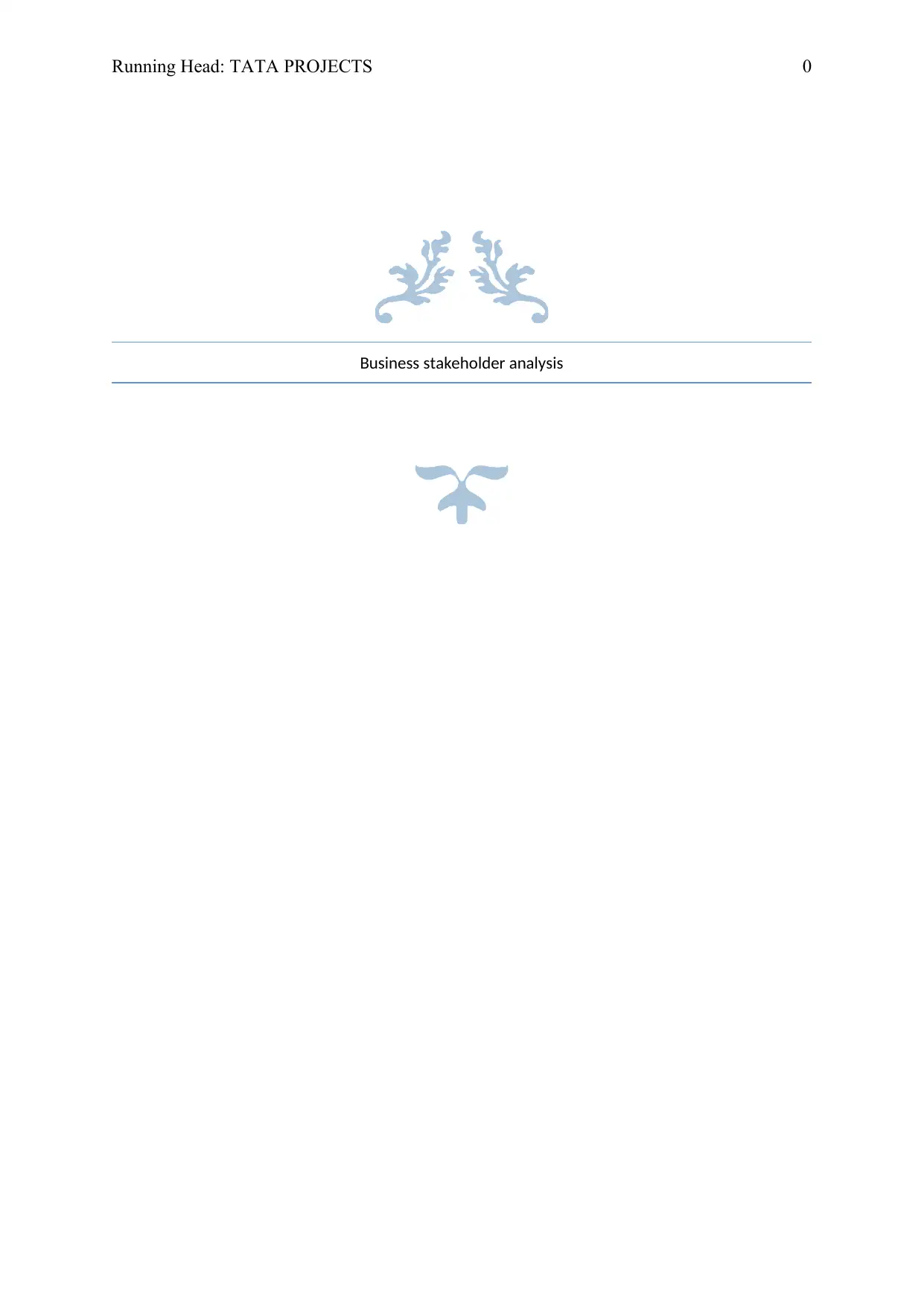
Running Head: TATA PROJECTS 0
Business stakeholder analysis
Business stakeholder analysis
Paraphrase This Document
Need a fresh take? Get an instant paraphrase of this document with our AI Paraphraser
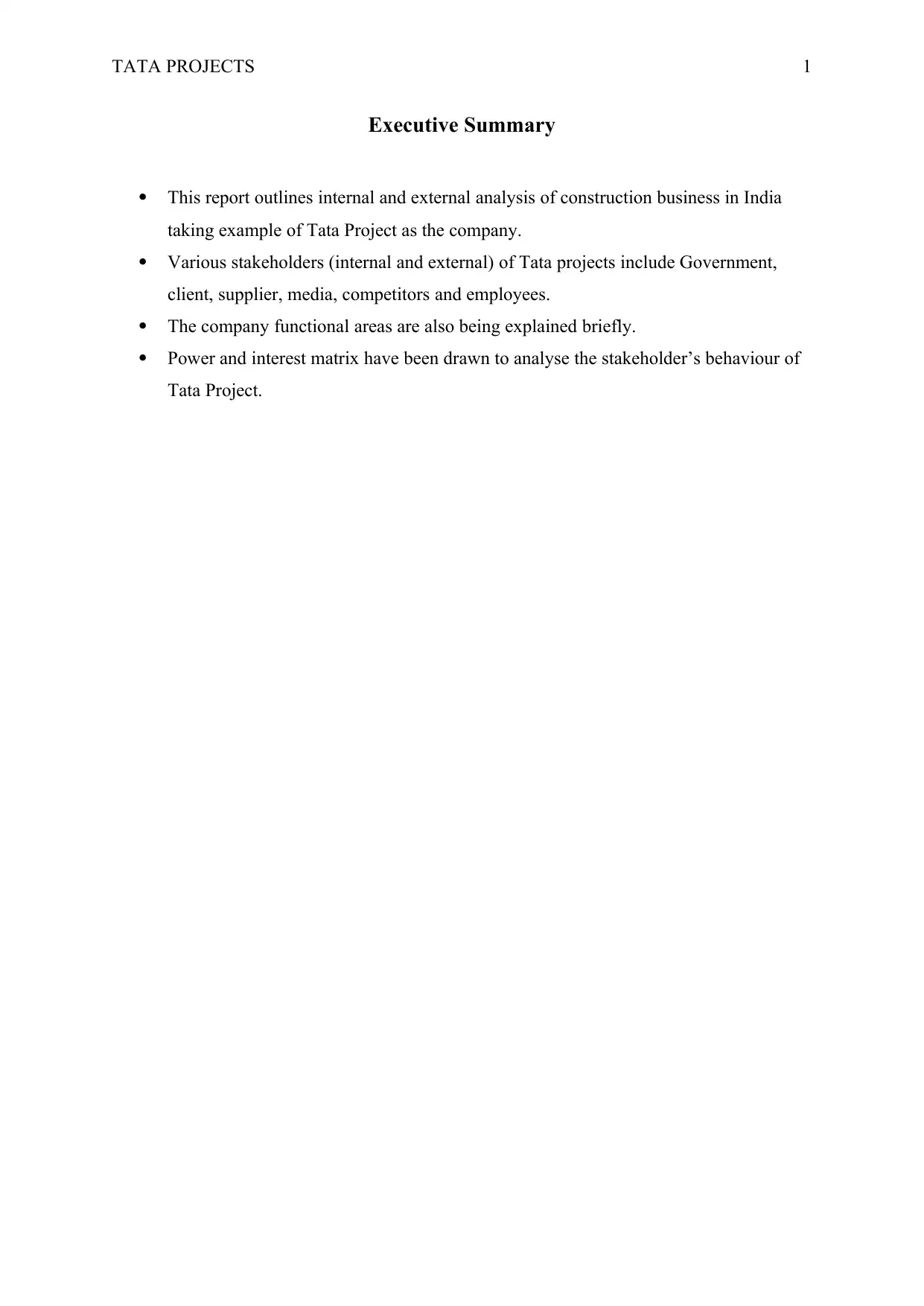
TATA PROJECTS 1
Executive Summary
This report outlines internal and external analysis of construction business in India
taking example of Tata Project as the company.
Various stakeholders (internal and external) of Tata projects include Government,
client, supplier, media, competitors and employees.
The company functional areas are also being explained briefly.
Power and interest matrix have been drawn to analyse the stakeholder’s behaviour of
Tata Project.
Executive Summary
This report outlines internal and external analysis of construction business in India
taking example of Tata Project as the company.
Various stakeholders (internal and external) of Tata projects include Government,
client, supplier, media, competitors and employees.
The company functional areas are also being explained briefly.
Power and interest matrix have been drawn to analyse the stakeholder’s behaviour of
Tata Project.
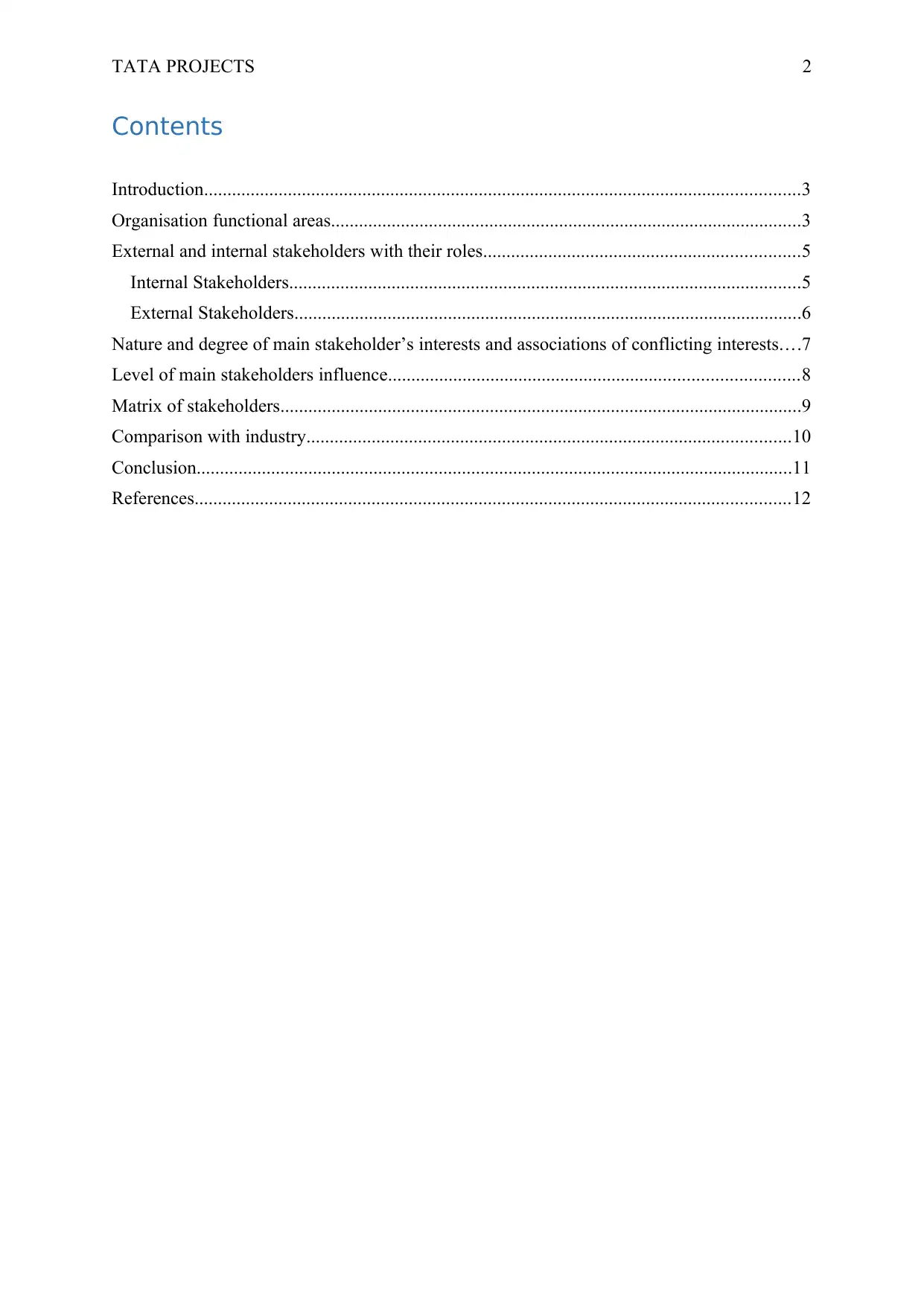
TATA PROJECTS 2
Contents
Introduction................................................................................................................................3
Organisation functional areas.....................................................................................................3
External and internal stakeholders with their roles....................................................................5
Internal Stakeholders..............................................................................................................5
External Stakeholders.............................................................................................................6
Nature and degree of main stakeholder’s interests and associations of conflicting interests....7
Level of main stakeholders influence........................................................................................8
Matrix of stakeholders................................................................................................................9
Comparison with industry........................................................................................................10
Conclusion................................................................................................................................11
References................................................................................................................................12
Contents
Introduction................................................................................................................................3
Organisation functional areas.....................................................................................................3
External and internal stakeholders with their roles....................................................................5
Internal Stakeholders..............................................................................................................5
External Stakeholders.............................................................................................................6
Nature and degree of main stakeholder’s interests and associations of conflicting interests....7
Level of main stakeholders influence........................................................................................8
Matrix of stakeholders................................................................................................................9
Comparison with industry........................................................................................................10
Conclusion................................................................................................................................11
References................................................................................................................................12
⊘ This is a preview!⊘
Do you want full access?
Subscribe today to unlock all pages.

Trusted by 1+ million students worldwide

TATA PROJECTS 3
Introduction
The construction business in India is one of the significant indicators of the
development as it generates investment opportunities through several connected sectors. In
2011-12, this industry has contributed an estimated US$ 3000 billion to the national GDP
(stadslogement-oudewater.nl, 2019). This industry relies greatly on cement for its operations
in the growth of shelter and other infrastructure facilities. In material development, global
research trends are associating with sourcing of substitutes demanded by the big cost of
conventional resources and challenges in accessing fund for construction development, the
necessity to reprocess waste material of agriculture for construction and the requirement to
uphold environmental balance.
Tata Projects is one of the leading company provides turnkey solutions for the
construction of roads, bridges, commercial buildings, airports, fully integrated metro and rail
systems. This makes the company as one of the India faster growing engineering,
procurement and construction firm with expertise and experience in deploying complex, large
industrial and urban infrastructure projects. The company also have a bright future as India’s
construction industry is expected to grow at an annual average of 6.6% between 2019 and
2028 (constructionweekonline.in, 2019). Tata projects are known to be one of the subsidiaries
of Tata group who have global footprints with more than 100 countries in six continents.
Over the years, Tata Projects has grown from a turnover of INR 34, 440 million in FY 2015
to INR 1, 30, 000 million in FY 19 (anticipated). This shows 39.39% year on year growth
(tataprojects.com, 2019). The company place active stakeholder engagement mechanisms in
place at all stakeholder – sensitive function, i.e. HR, promotion and marketing, CSR,
corporate communication and so on.
Organisation functional areas
The functional area of Tata projects divide the business into specialised divisions
typically consists of their business operating stages towards achievement of strategic goals.
Each functional area helps Tata projects in achieving its strategic goals developed by the top
executives of management. The various functional areas of Tata projects include –
Introduction
The construction business in India is one of the significant indicators of the
development as it generates investment opportunities through several connected sectors. In
2011-12, this industry has contributed an estimated US$ 3000 billion to the national GDP
(stadslogement-oudewater.nl, 2019). This industry relies greatly on cement for its operations
in the growth of shelter and other infrastructure facilities. In material development, global
research trends are associating with sourcing of substitutes demanded by the big cost of
conventional resources and challenges in accessing fund for construction development, the
necessity to reprocess waste material of agriculture for construction and the requirement to
uphold environmental balance.
Tata Projects is one of the leading company provides turnkey solutions for the
construction of roads, bridges, commercial buildings, airports, fully integrated metro and rail
systems. This makes the company as one of the India faster growing engineering,
procurement and construction firm with expertise and experience in deploying complex, large
industrial and urban infrastructure projects. The company also have a bright future as India’s
construction industry is expected to grow at an annual average of 6.6% between 2019 and
2028 (constructionweekonline.in, 2019). Tata projects are known to be one of the subsidiaries
of Tata group who have global footprints with more than 100 countries in six continents.
Over the years, Tata Projects has grown from a turnover of INR 34, 440 million in FY 2015
to INR 1, 30, 000 million in FY 19 (anticipated). This shows 39.39% year on year growth
(tataprojects.com, 2019). The company place active stakeholder engagement mechanisms in
place at all stakeholder – sensitive function, i.e. HR, promotion and marketing, CSR,
corporate communication and so on.
Organisation functional areas
The functional area of Tata projects divide the business into specialised divisions
typically consists of their business operating stages towards achievement of strategic goals.
Each functional area helps Tata projects in achieving its strategic goals developed by the top
executives of management. The various functional areas of Tata projects include –
Paraphrase This Document
Need a fresh take? Get an instant paraphrase of this document with our AI Paraphraser
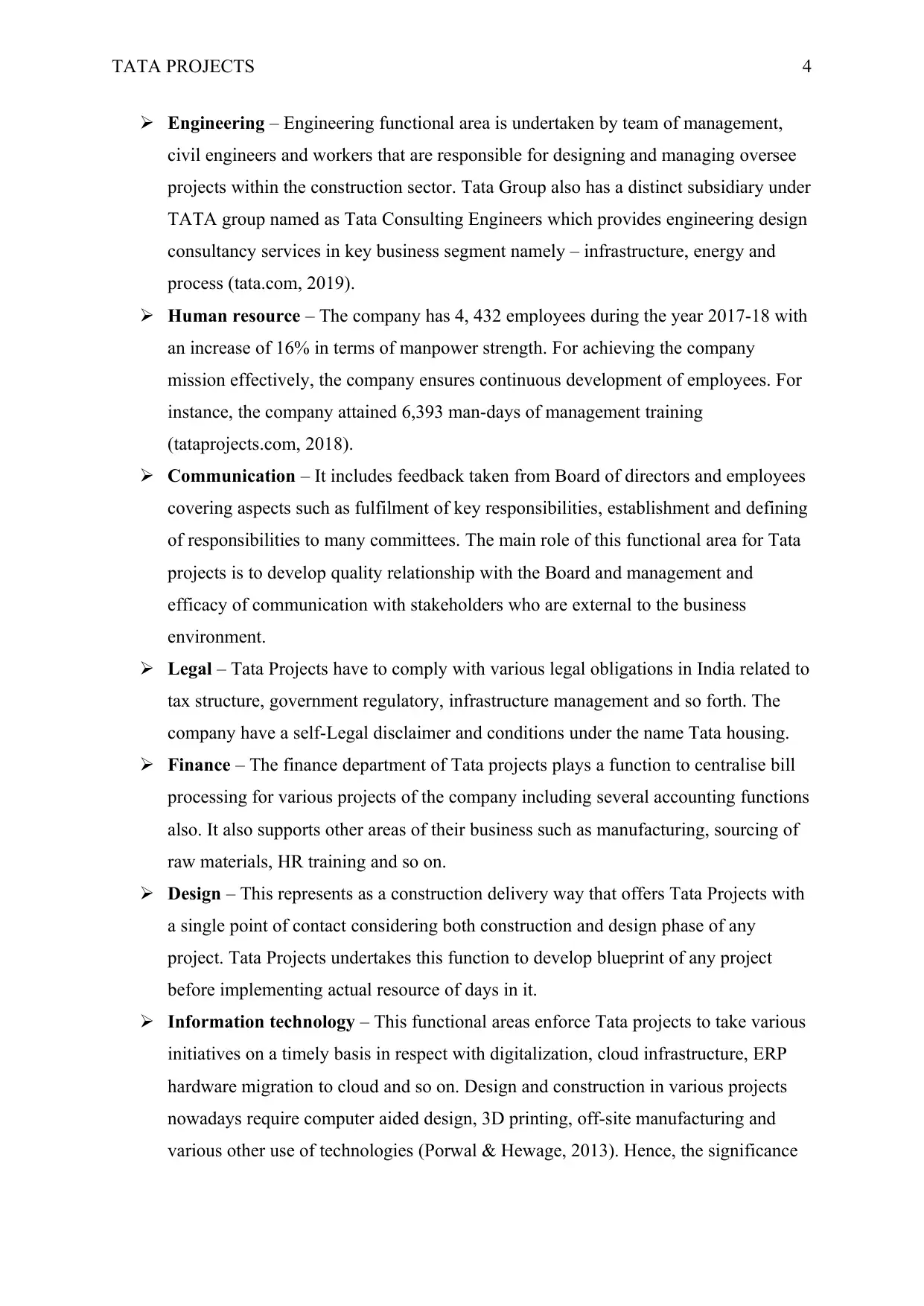
TATA PROJECTS 4
Engineering – Engineering functional area is undertaken by team of management,
civil engineers and workers that are responsible for designing and managing oversee
projects within the construction sector. Tata Group also has a distinct subsidiary under
TATA group named as Tata Consulting Engineers which provides engineering design
consultancy services in key business segment namely – infrastructure, energy and
process (tata.com, 2019).
Human resource – The company has 4, 432 employees during the year 2017-18 with
an increase of 16% in terms of manpower strength. For achieving the company
mission effectively, the company ensures continuous development of employees. For
instance, the company attained 6,393 man-days of management training
(tataprojects.com, 2018).
Communication – It includes feedback taken from Board of directors and employees
covering aspects such as fulfilment of key responsibilities, establishment and defining
of responsibilities to many committees. The main role of this functional area for Tata
projects is to develop quality relationship with the Board and management and
efficacy of communication with stakeholders who are external to the business
environment.
Legal – Tata Projects have to comply with various legal obligations in India related to
tax structure, government regulatory, infrastructure management and so forth. The
company have a self-Legal disclaimer and conditions under the name Tata housing.
Finance – The finance department of Tata projects plays a function to centralise bill
processing for various projects of the company including several accounting functions
also. It also supports other areas of their business such as manufacturing, sourcing of
raw materials, HR training and so on.
Design – This represents as a construction delivery way that offers Tata Projects with
a single point of contact considering both construction and design phase of any
project. Tata Projects undertakes this function to develop blueprint of any project
before implementing actual resource of days in it.
Information technology – This functional areas enforce Tata projects to take various
initiatives on a timely basis in respect with digitalization, cloud infrastructure, ERP
hardware migration to cloud and so on. Design and construction in various projects
nowadays require computer aided design, 3D printing, off-site manufacturing and
various other use of technologies (Porwal & Hewage, 2013). Hence, the significance
Engineering – Engineering functional area is undertaken by team of management,
civil engineers and workers that are responsible for designing and managing oversee
projects within the construction sector. Tata Group also has a distinct subsidiary under
TATA group named as Tata Consulting Engineers which provides engineering design
consultancy services in key business segment namely – infrastructure, energy and
process (tata.com, 2019).
Human resource – The company has 4, 432 employees during the year 2017-18 with
an increase of 16% in terms of manpower strength. For achieving the company
mission effectively, the company ensures continuous development of employees. For
instance, the company attained 6,393 man-days of management training
(tataprojects.com, 2018).
Communication – It includes feedback taken from Board of directors and employees
covering aspects such as fulfilment of key responsibilities, establishment and defining
of responsibilities to many committees. The main role of this functional area for Tata
projects is to develop quality relationship with the Board and management and
efficacy of communication with stakeholders who are external to the business
environment.
Legal – Tata Projects have to comply with various legal obligations in India related to
tax structure, government regulatory, infrastructure management and so forth. The
company have a self-Legal disclaimer and conditions under the name Tata housing.
Finance – The finance department of Tata projects plays a function to centralise bill
processing for various projects of the company including several accounting functions
also. It also supports other areas of their business such as manufacturing, sourcing of
raw materials, HR training and so on.
Design – This represents as a construction delivery way that offers Tata Projects with
a single point of contact considering both construction and design phase of any
project. Tata Projects undertakes this function to develop blueprint of any project
before implementing actual resource of days in it.
Information technology – This functional areas enforce Tata projects to take various
initiatives on a timely basis in respect with digitalization, cloud infrastructure, ERP
hardware migration to cloud and so on. Design and construction in various projects
nowadays require computer aided design, 3D printing, off-site manufacturing and
various other use of technologies (Porwal & Hewage, 2013). Hence, the significance
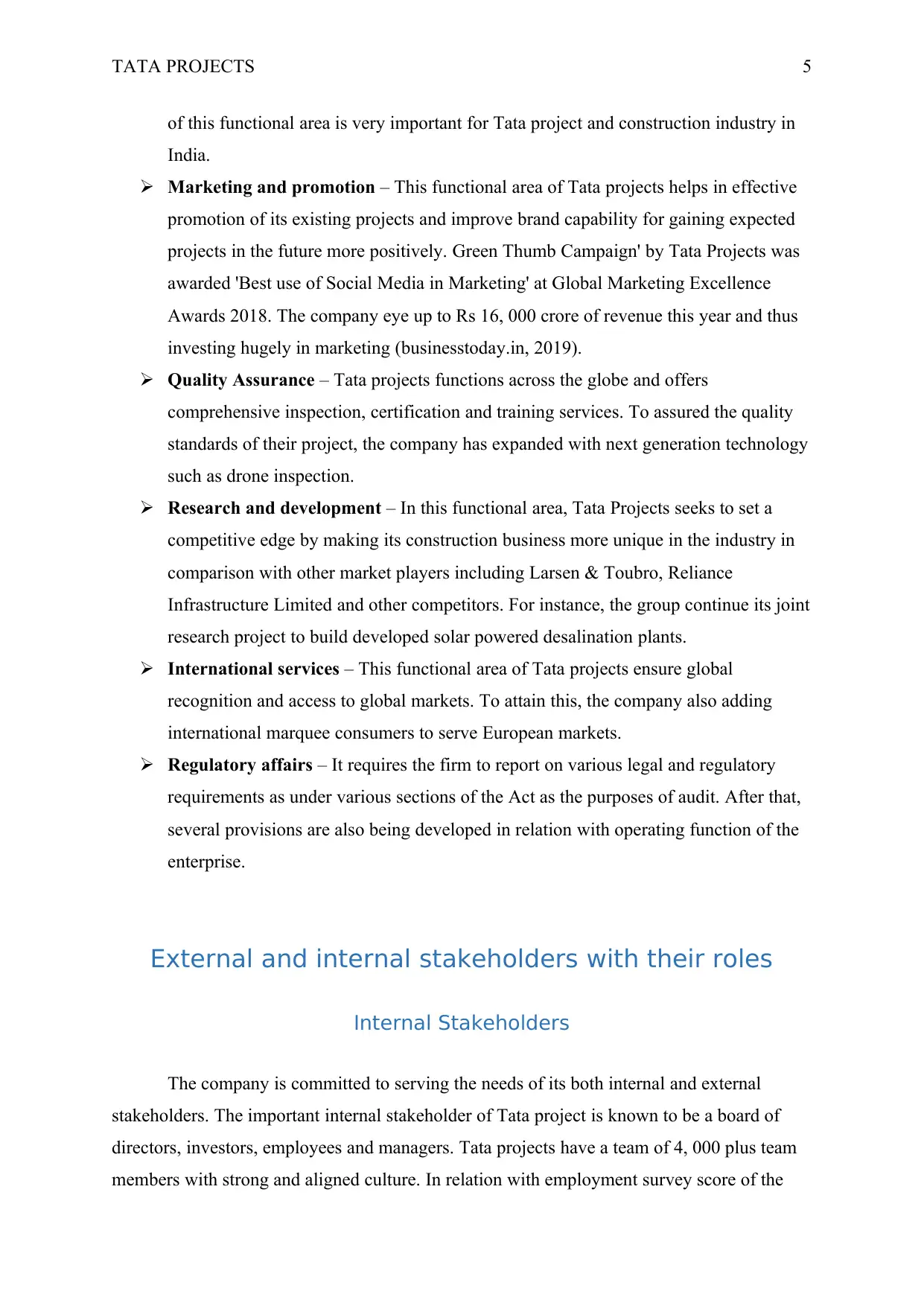
TATA PROJECTS 5
of this functional area is very important for Tata project and construction industry in
India.
Marketing and promotion – This functional area of Tata projects helps in effective
promotion of its existing projects and improve brand capability for gaining expected
projects in the future more positively. Green Thumb Campaign' by Tata Projects was
awarded 'Best use of Social Media in Marketing' at Global Marketing Excellence
Awards 2018. The company eye up to Rs 16, 000 crore of revenue this year and thus
investing hugely in marketing (businesstoday.in, 2019).
Quality Assurance – Tata projects functions across the globe and offers
comprehensive inspection, certification and training services. To assured the quality
standards of their project, the company has expanded with next generation technology
such as drone inspection.
Research and development – In this functional area, Tata Projects seeks to set a
competitive edge by making its construction business more unique in the industry in
comparison with other market players including Larsen & Toubro, Reliance
Infrastructure Limited and other competitors. For instance, the group continue its joint
research project to build developed solar powered desalination plants.
International services – This functional area of Tata projects ensure global
recognition and access to global markets. To attain this, the company also adding
international marquee consumers to serve European markets.
Regulatory affairs – It requires the firm to report on various legal and regulatory
requirements as under various sections of the Act as the purposes of audit. After that,
several provisions are also being developed in relation with operating function of the
enterprise.
External and internal stakeholders with their roles
Internal Stakeholders
The company is committed to serving the needs of its both internal and external
stakeholders. The important internal stakeholder of Tata project is known to be a board of
directors, investors, employees and managers. Tata projects have a team of 4, 000 plus team
members with strong and aligned culture. In relation with employment survey score of the
of this functional area is very important for Tata project and construction industry in
India.
Marketing and promotion – This functional area of Tata projects helps in effective
promotion of its existing projects and improve brand capability for gaining expected
projects in the future more positively. Green Thumb Campaign' by Tata Projects was
awarded 'Best use of Social Media in Marketing' at Global Marketing Excellence
Awards 2018. The company eye up to Rs 16, 000 crore of revenue this year and thus
investing hugely in marketing (businesstoday.in, 2019).
Quality Assurance – Tata projects functions across the globe and offers
comprehensive inspection, certification and training services. To assured the quality
standards of their project, the company has expanded with next generation technology
such as drone inspection.
Research and development – In this functional area, Tata Projects seeks to set a
competitive edge by making its construction business more unique in the industry in
comparison with other market players including Larsen & Toubro, Reliance
Infrastructure Limited and other competitors. For instance, the group continue its joint
research project to build developed solar powered desalination plants.
International services – This functional area of Tata projects ensure global
recognition and access to global markets. To attain this, the company also adding
international marquee consumers to serve European markets.
Regulatory affairs – It requires the firm to report on various legal and regulatory
requirements as under various sections of the Act as the purposes of audit. After that,
several provisions are also being developed in relation with operating function of the
enterprise.
External and internal stakeholders with their roles
Internal Stakeholders
The company is committed to serving the needs of its both internal and external
stakeholders. The important internal stakeholder of Tata project is known to be a board of
directors, investors, employees and managers. Tata projects have a team of 4, 000 plus team
members with strong and aligned culture. In relation with employment survey score of the
⊘ This is a preview!⊘
Do you want full access?
Subscribe today to unlock all pages.

Trusted by 1+ million students worldwide
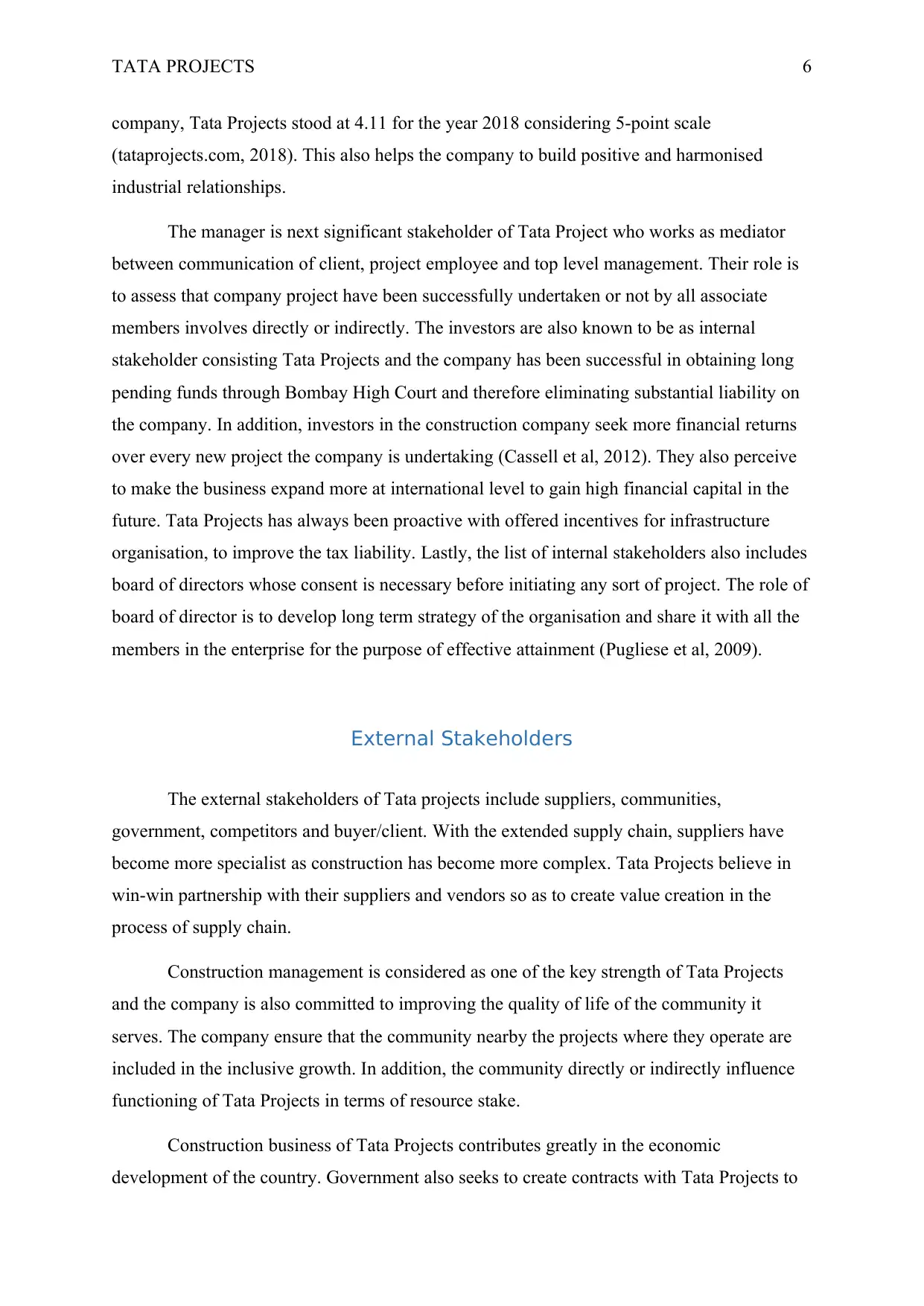
TATA PROJECTS 6
company, Tata Projects stood at 4.11 for the year 2018 considering 5-point scale
(tataprojects.com, 2018). This also helps the company to build positive and harmonised
industrial relationships.
The manager is next significant stakeholder of Tata Project who works as mediator
between communication of client, project employee and top level management. Their role is
to assess that company project have been successfully undertaken or not by all associate
members involves directly or indirectly. The investors are also known to be as internal
stakeholder consisting Tata Projects and the company has been successful in obtaining long
pending funds through Bombay High Court and therefore eliminating substantial liability on
the company. In addition, investors in the construction company seek more financial returns
over every new project the company is undertaking (Cassell et al, 2012). They also perceive
to make the business expand more at international level to gain high financial capital in the
future. Tata Projects has always been proactive with offered incentives for infrastructure
organisation, to improve the tax liability. Lastly, the list of internal stakeholders also includes
board of directors whose consent is necessary before initiating any sort of project. The role of
board of director is to develop long term strategy of the organisation and share it with all the
members in the enterprise for the purpose of effective attainment (Pugliese et al, 2009).
External Stakeholders
The external stakeholders of Tata projects include suppliers, communities,
government, competitors and buyer/client. With the extended supply chain, suppliers have
become more specialist as construction has become more complex. Tata Projects believe in
win-win partnership with their suppliers and vendors so as to create value creation in the
process of supply chain.
Construction management is considered as one of the key strength of Tata Projects
and the company is also committed to improving the quality of life of the community it
serves. The company ensure that the community nearby the projects where they operate are
included in the inclusive growth. In addition, the community directly or indirectly influence
functioning of Tata Projects in terms of resource stake.
Construction business of Tata Projects contributes greatly in the economic
development of the country. Government also seeks to create contracts with Tata Projects to
company, Tata Projects stood at 4.11 for the year 2018 considering 5-point scale
(tataprojects.com, 2018). This also helps the company to build positive and harmonised
industrial relationships.
The manager is next significant stakeholder of Tata Project who works as mediator
between communication of client, project employee and top level management. Their role is
to assess that company project have been successfully undertaken or not by all associate
members involves directly or indirectly. The investors are also known to be as internal
stakeholder consisting Tata Projects and the company has been successful in obtaining long
pending funds through Bombay High Court and therefore eliminating substantial liability on
the company. In addition, investors in the construction company seek more financial returns
over every new project the company is undertaking (Cassell et al, 2012). They also perceive
to make the business expand more at international level to gain high financial capital in the
future. Tata Projects has always been proactive with offered incentives for infrastructure
organisation, to improve the tax liability. Lastly, the list of internal stakeholders also includes
board of directors whose consent is necessary before initiating any sort of project. The role of
board of director is to develop long term strategy of the organisation and share it with all the
members in the enterprise for the purpose of effective attainment (Pugliese et al, 2009).
External Stakeholders
The external stakeholders of Tata projects include suppliers, communities,
government, competitors and buyer/client. With the extended supply chain, suppliers have
become more specialist as construction has become more complex. Tata Projects believe in
win-win partnership with their suppliers and vendors so as to create value creation in the
process of supply chain.
Construction management is considered as one of the key strength of Tata Projects
and the company is also committed to improving the quality of life of the community it
serves. The company ensure that the community nearby the projects where they operate are
included in the inclusive growth. In addition, the community directly or indirectly influence
functioning of Tata Projects in terms of resource stake.
Construction business of Tata Projects contributes greatly in the economic
development of the country. Government also seeks to create contracts with Tata Projects to
Paraphrase This Document
Need a fresh take? Get an instant paraphrase of this document with our AI Paraphraser
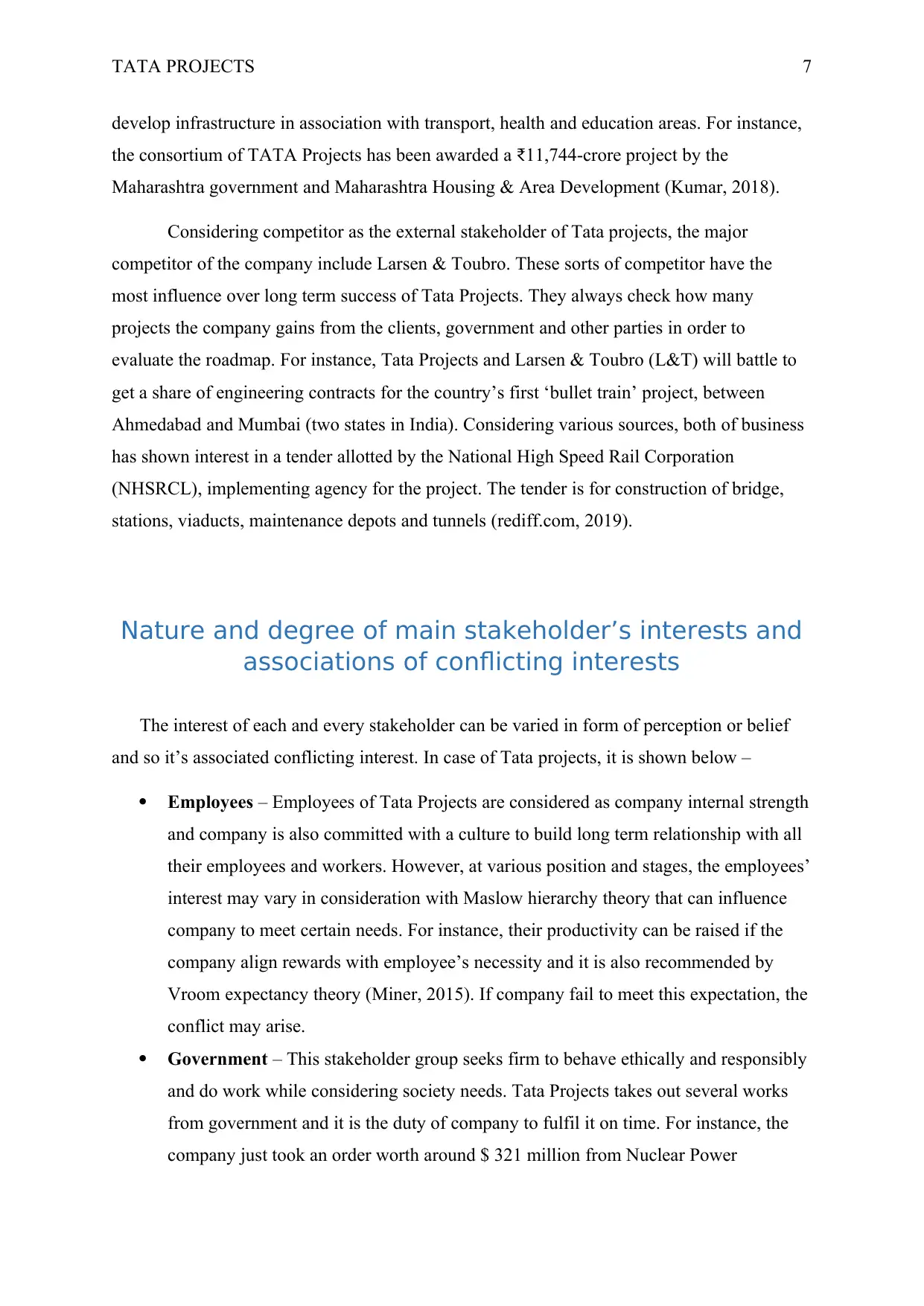
TATA PROJECTS 7
develop infrastructure in association with transport, health and education areas. For instance,
the consortium of TATA Projects has been awarded a ₹11,744-crore project by the
Maharashtra government and Maharashtra Housing & Area Development (Kumar, 2018).
Considering competitor as the external stakeholder of Tata projects, the major
competitor of the company include Larsen & Toubro. These sorts of competitor have the
most influence over long term success of Tata Projects. They always check how many
projects the company gains from the clients, government and other parties in order to
evaluate the roadmap. For instance, Tata Projects and Larsen & Toubro (L&T) will battle to
get a share of engineering contracts for the country’s first ‘bullet train’ project, between
Ahmedabad and Mumbai (two states in India). Considering various sources, both of business
has shown interest in a tender allotted by the National High Speed Rail Corporation
(NHSRCL), implementing agency for the project. The tender is for construction of bridge,
stations, viaducts, maintenance depots and tunnels (rediff.com, 2019).
Nature and degree of main stakeholder’s interests and
associations of conflicting interests
The interest of each and every stakeholder can be varied in form of perception or belief
and so it’s associated conflicting interest. In case of Tata projects, it is shown below –
Employees – Employees of Tata Projects are considered as company internal strength
and company is also committed with a culture to build long term relationship with all
their employees and workers. However, at various position and stages, the employees’
interest may vary in consideration with Maslow hierarchy theory that can influence
company to meet certain needs. For instance, their productivity can be raised if the
company align rewards with employee’s necessity and it is also recommended by
Vroom expectancy theory (Miner, 2015). If company fail to meet this expectation, the
conflict may arise.
Government – This stakeholder group seeks firm to behave ethically and responsibly
and do work while considering society needs. Tata Projects takes out several works
from government and it is the duty of company to fulfil it on time. For instance, the
company just took an order worth around $ 321 million from Nuclear Power
develop infrastructure in association with transport, health and education areas. For instance,
the consortium of TATA Projects has been awarded a ₹11,744-crore project by the
Maharashtra government and Maharashtra Housing & Area Development (Kumar, 2018).
Considering competitor as the external stakeholder of Tata projects, the major
competitor of the company include Larsen & Toubro. These sorts of competitor have the
most influence over long term success of Tata Projects. They always check how many
projects the company gains from the clients, government and other parties in order to
evaluate the roadmap. For instance, Tata Projects and Larsen & Toubro (L&T) will battle to
get a share of engineering contracts for the country’s first ‘bullet train’ project, between
Ahmedabad and Mumbai (two states in India). Considering various sources, both of business
has shown interest in a tender allotted by the National High Speed Rail Corporation
(NHSRCL), implementing agency for the project. The tender is for construction of bridge,
stations, viaducts, maintenance depots and tunnels (rediff.com, 2019).
Nature and degree of main stakeholder’s interests and
associations of conflicting interests
The interest of each and every stakeholder can be varied in form of perception or belief
and so it’s associated conflicting interest. In case of Tata projects, it is shown below –
Employees – Employees of Tata Projects are considered as company internal strength
and company is also committed with a culture to build long term relationship with all
their employees and workers. However, at various position and stages, the employees’
interest may vary in consideration with Maslow hierarchy theory that can influence
company to meet certain needs. For instance, their productivity can be raised if the
company align rewards with employee’s necessity and it is also recommended by
Vroom expectancy theory (Miner, 2015). If company fail to meet this expectation, the
conflict may arise.
Government – This stakeholder group seeks firm to behave ethically and responsibly
and do work while considering society needs. Tata Projects takes out several works
from government and it is the duty of company to fulfil it on time. For instance, the
company just took an order worth around $ 321 million from Nuclear Power
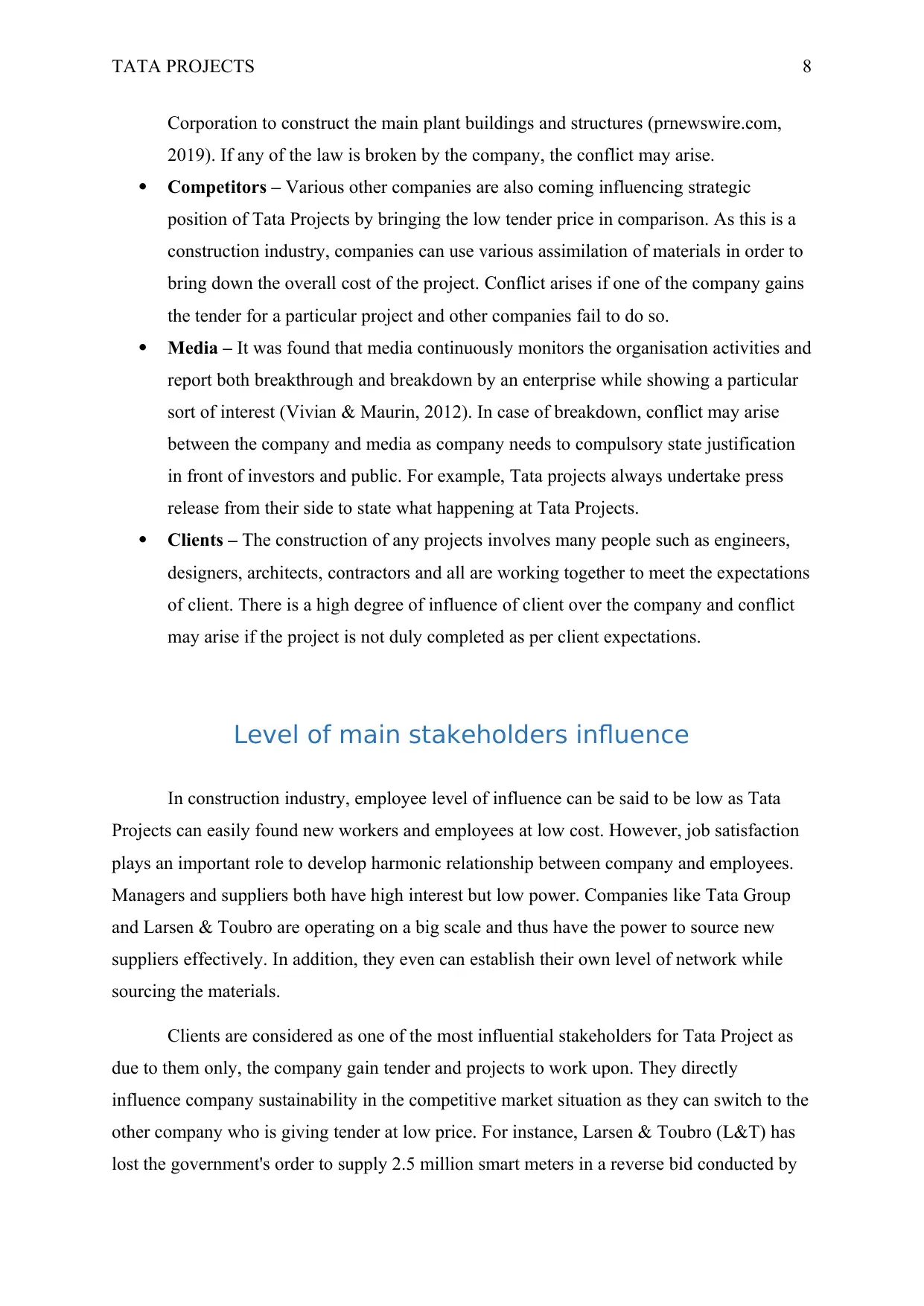
TATA PROJECTS 8
Corporation to construct the main plant buildings and structures (prnewswire.com,
2019). If any of the law is broken by the company, the conflict may arise.
Competitors – Various other companies are also coming influencing strategic
position of Tata Projects by bringing the low tender price in comparison. As this is a
construction industry, companies can use various assimilation of materials in order to
bring down the overall cost of the project. Conflict arises if one of the company gains
the tender for a particular project and other companies fail to do so.
Media – It was found that media continuously monitors the organisation activities and
report both breakthrough and breakdown by an enterprise while showing a particular
sort of interest (Vivian & Maurin, 2012). In case of breakdown, conflict may arise
between the company and media as company needs to compulsory state justification
in front of investors and public. For example, Tata projects always undertake press
release from their side to state what happening at Tata Projects.
Clients – The construction of any projects involves many people such as engineers,
designers, architects, contractors and all are working together to meet the expectations
of client. There is a high degree of influence of client over the company and conflict
may arise if the project is not duly completed as per client expectations.
Level of main stakeholders influence
In construction industry, employee level of influence can be said to be low as Tata
Projects can easily found new workers and employees at low cost. However, job satisfaction
plays an important role to develop harmonic relationship between company and employees.
Managers and suppliers both have high interest but low power. Companies like Tata Group
and Larsen & Toubro are operating on a big scale and thus have the power to source new
suppliers effectively. In addition, they even can establish their own level of network while
sourcing the materials.
Clients are considered as one of the most influential stakeholders for Tata Project as
due to them only, the company gain tender and projects to work upon. They directly
influence company sustainability in the competitive market situation as they can switch to the
other company who is giving tender at low price. For instance, Larsen & Toubro (L&T) has
lost the government's order to supply 2.5 million smart meters in a reverse bid conducted by
Corporation to construct the main plant buildings and structures (prnewswire.com,
2019). If any of the law is broken by the company, the conflict may arise.
Competitors – Various other companies are also coming influencing strategic
position of Tata Projects by bringing the low tender price in comparison. As this is a
construction industry, companies can use various assimilation of materials in order to
bring down the overall cost of the project. Conflict arises if one of the company gains
the tender for a particular project and other companies fail to do so.
Media – It was found that media continuously monitors the organisation activities and
report both breakthrough and breakdown by an enterprise while showing a particular
sort of interest (Vivian & Maurin, 2012). In case of breakdown, conflict may arise
between the company and media as company needs to compulsory state justification
in front of investors and public. For example, Tata projects always undertake press
release from their side to state what happening at Tata Projects.
Clients – The construction of any projects involves many people such as engineers,
designers, architects, contractors and all are working together to meet the expectations
of client. There is a high degree of influence of client over the company and conflict
may arise if the project is not duly completed as per client expectations.
Level of main stakeholders influence
In construction industry, employee level of influence can be said to be low as Tata
Projects can easily found new workers and employees at low cost. However, job satisfaction
plays an important role to develop harmonic relationship between company and employees.
Managers and suppliers both have high interest but low power. Companies like Tata Group
and Larsen & Toubro are operating on a big scale and thus have the power to source new
suppliers effectively. In addition, they even can establish their own level of network while
sourcing the materials.
Clients are considered as one of the most influential stakeholders for Tata Project as
due to them only, the company gain tender and projects to work upon. They directly
influence company sustainability in the competitive market situation as they can switch to the
other company who is giving tender at low price. For instance, Larsen & Toubro (L&T) has
lost the government's order to supply 2.5 million smart meters in a reverse bid conducted by
⊘ This is a preview!⊘
Do you want full access?
Subscribe today to unlock all pages.

Trusted by 1+ million students worldwide
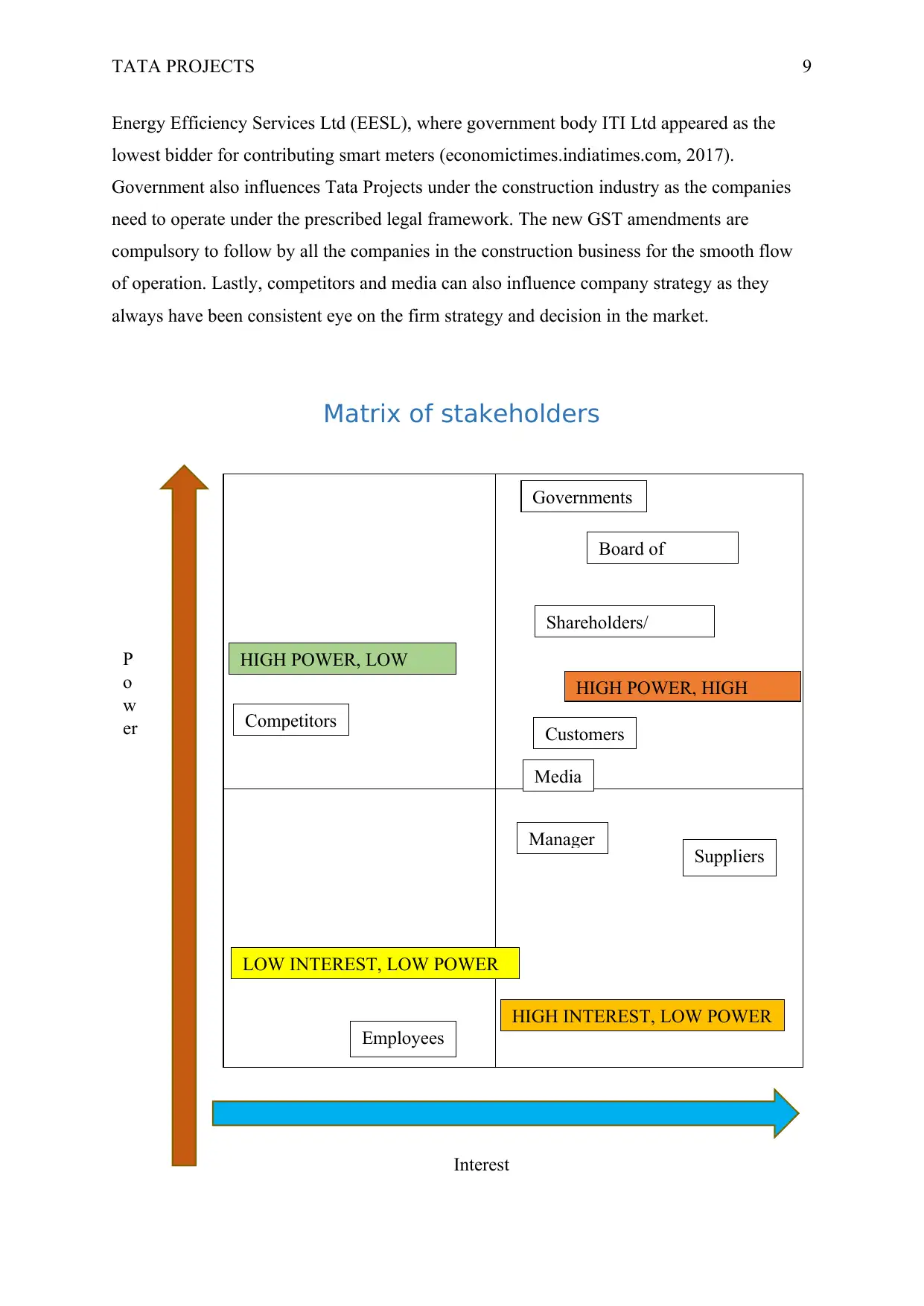
TATA PROJECTS 9
Energy Efficiency Services Ltd (EESL), where government body ITI Ltd appeared as the
lowest bidder for contributing smart meters (economictimes.indiatimes.com, 2017).
Government also influences Tata Projects under the construction industry as the companies
need to operate under the prescribed legal framework. The new GST amendments are
compulsory to follow by all the companies in the construction business for the smooth flow
of operation. Lastly, competitors and media can also influence company strategy as they
always have been consistent eye on the firm strategy and decision in the market.
Matrix of stakeholders
P
o
w
er
Interest
Governments
Shareholders/
Customers
Competitors
Employees
Manager
LOW INTEREST, LOW POWER
Suppliers
HIGH POWER, HIGH
HIGH INTEREST, LOW POWER
HIGH POWER, LOW
Board of
Media
Energy Efficiency Services Ltd (EESL), where government body ITI Ltd appeared as the
lowest bidder for contributing smart meters (economictimes.indiatimes.com, 2017).
Government also influences Tata Projects under the construction industry as the companies
need to operate under the prescribed legal framework. The new GST amendments are
compulsory to follow by all the companies in the construction business for the smooth flow
of operation. Lastly, competitors and media can also influence company strategy as they
always have been consistent eye on the firm strategy and decision in the market.
Matrix of stakeholders
P
o
w
er
Interest
Governments
Shareholders/
Customers
Competitors
Employees
Manager
LOW INTEREST, LOW POWER
Suppliers
HIGH POWER, HIGH
HIGH INTEREST, LOW POWER
HIGH POWER, LOW
Board of
Media
Paraphrase This Document
Need a fresh take? Get an instant paraphrase of this document with our AI Paraphraser
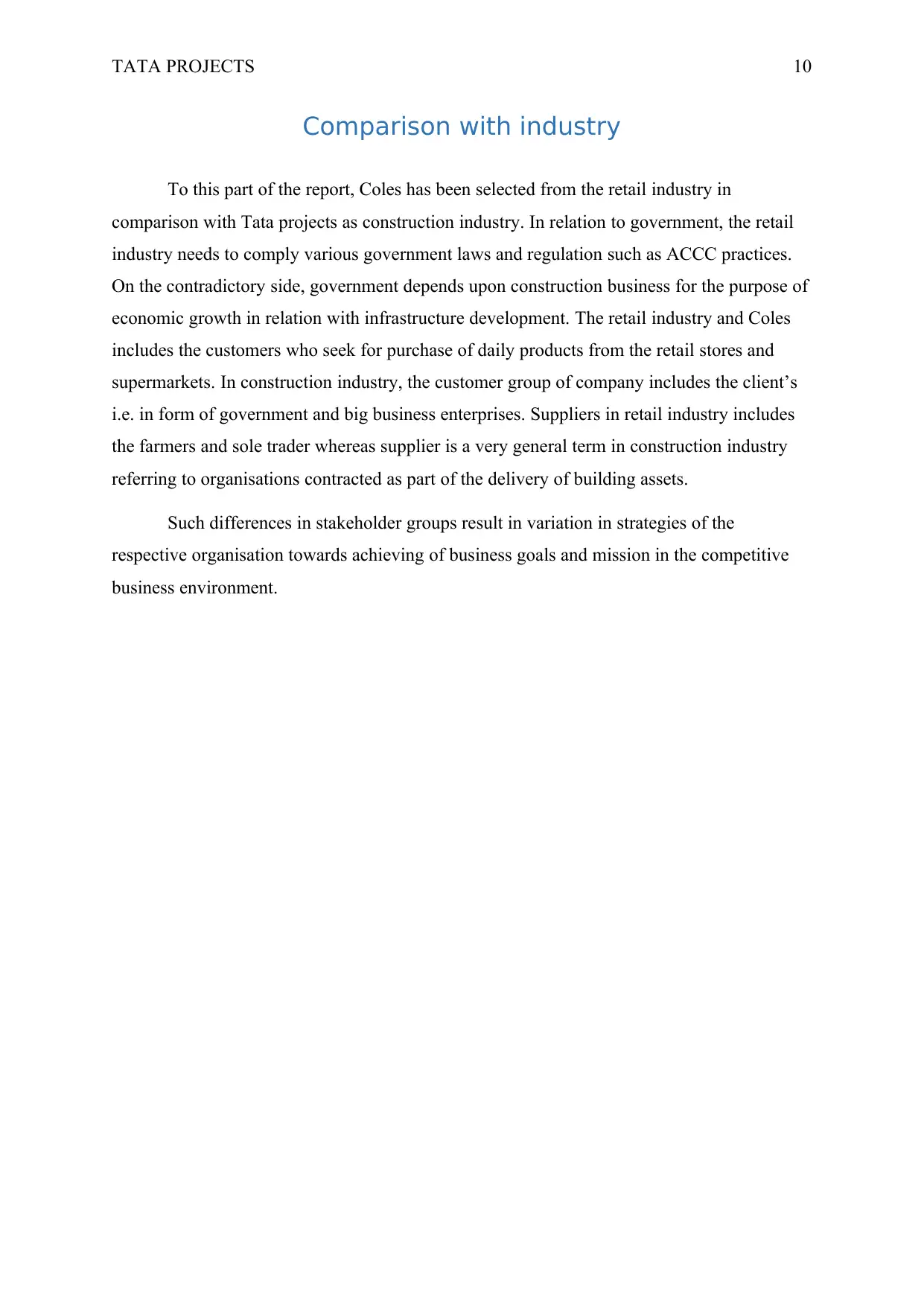
TATA PROJECTS 10
Comparison with industry
To this part of the report, Coles has been selected from the retail industry in
comparison with Tata projects as construction industry. In relation to government, the retail
industry needs to comply various government laws and regulation such as ACCC practices.
On the contradictory side, government depends upon construction business for the purpose of
economic growth in relation with infrastructure development. The retail industry and Coles
includes the customers who seek for purchase of daily products from the retail stores and
supermarkets. In construction industry, the customer group of company includes the client’s
i.e. in form of government and big business enterprises. Suppliers in retail industry includes
the farmers and sole trader whereas supplier is a very general term in construction industry
referring to organisations contracted as part of the delivery of building assets.
Such differences in stakeholder groups result in variation in strategies of the
respective organisation towards achieving of business goals and mission in the competitive
business environment.
Comparison with industry
To this part of the report, Coles has been selected from the retail industry in
comparison with Tata projects as construction industry. In relation to government, the retail
industry needs to comply various government laws and regulation such as ACCC practices.
On the contradictory side, government depends upon construction business for the purpose of
economic growth in relation with infrastructure development. The retail industry and Coles
includes the customers who seek for purchase of daily products from the retail stores and
supermarkets. In construction industry, the customer group of company includes the client’s
i.e. in form of government and big business enterprises. Suppliers in retail industry includes
the farmers and sole trader whereas supplier is a very general term in construction industry
referring to organisations contracted as part of the delivery of building assets.
Such differences in stakeholder groups result in variation in strategies of the
respective organisation towards achieving of business goals and mission in the competitive
business environment.
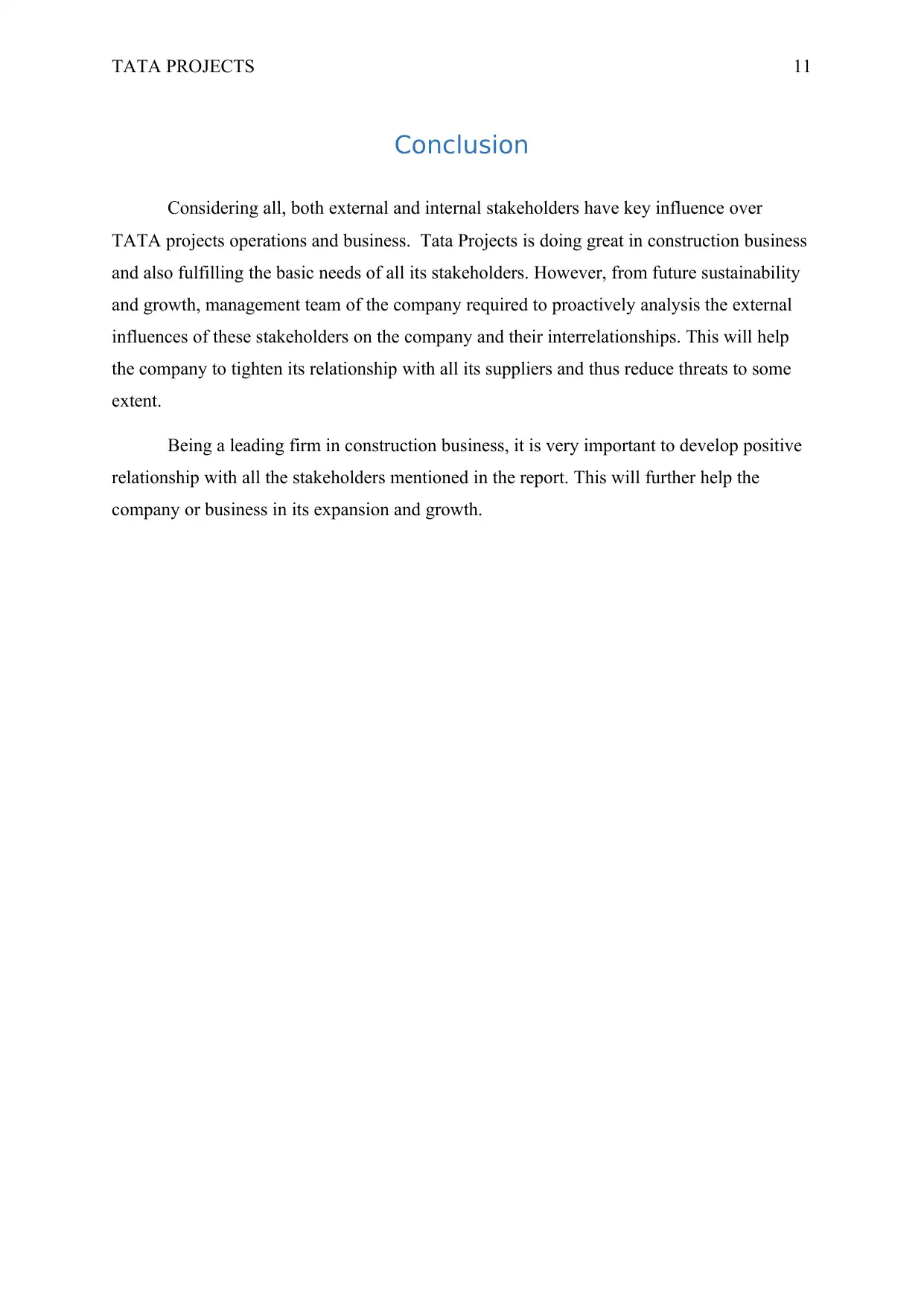
TATA PROJECTS 11
Conclusion
Considering all, both external and internal stakeholders have key influence over
TATA projects operations and business. Tata Projects is doing great in construction business
and also fulfilling the basic needs of all its stakeholders. However, from future sustainability
and growth, management team of the company required to proactively analysis the external
influences of these stakeholders on the company and their interrelationships. This will help
the company to tighten its relationship with all its suppliers and thus reduce threats to some
extent.
Being a leading firm in construction business, it is very important to develop positive
relationship with all the stakeholders mentioned in the report. This will further help the
company or business in its expansion and growth.
Conclusion
Considering all, both external and internal stakeholders have key influence over
TATA projects operations and business. Tata Projects is doing great in construction business
and also fulfilling the basic needs of all its stakeholders. However, from future sustainability
and growth, management team of the company required to proactively analysis the external
influences of these stakeholders on the company and their interrelationships. This will help
the company to tighten its relationship with all its suppliers and thus reduce threats to some
extent.
Being a leading firm in construction business, it is very important to develop positive
relationship with all the stakeholders mentioned in the report. This will further help the
company or business in its expansion and growth.
⊘ This is a preview!⊘
Do you want full access?
Subscribe today to unlock all pages.

Trusted by 1+ million students worldwide
1 out of 14
Related Documents
Your All-in-One AI-Powered Toolkit for Academic Success.
+13062052269
info@desklib.com
Available 24*7 on WhatsApp / Email
![[object Object]](/_next/static/media/star-bottom.7253800d.svg)
Unlock your academic potential
Copyright © 2020–2025 A2Z Services. All Rights Reserved. Developed and managed by ZUCOL.





